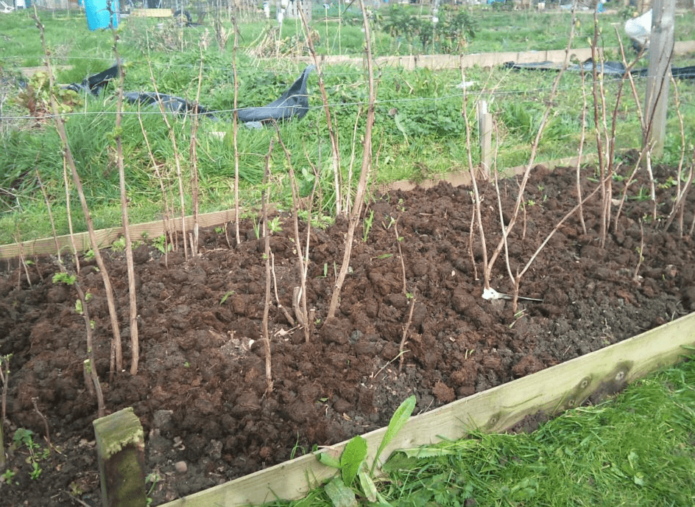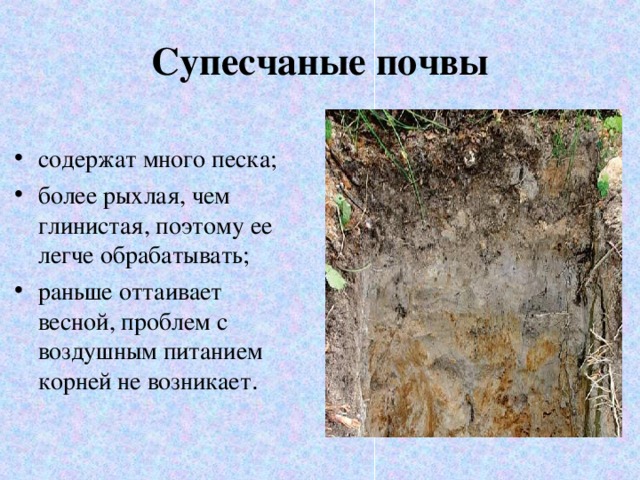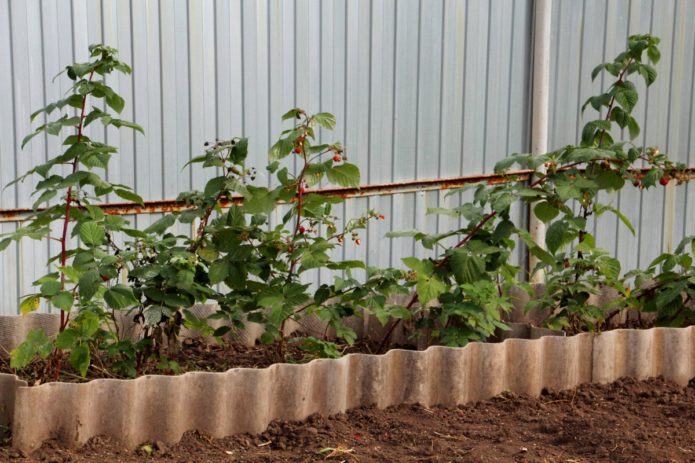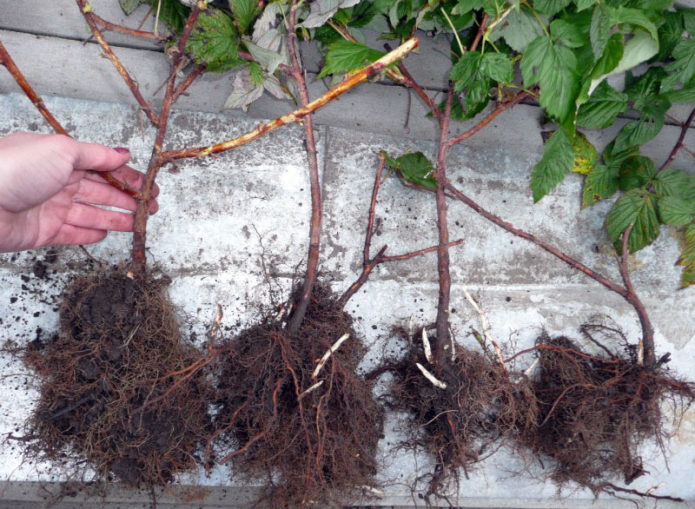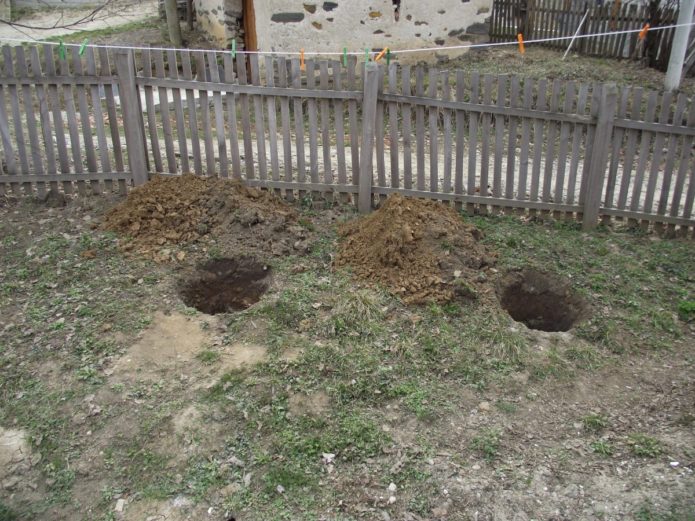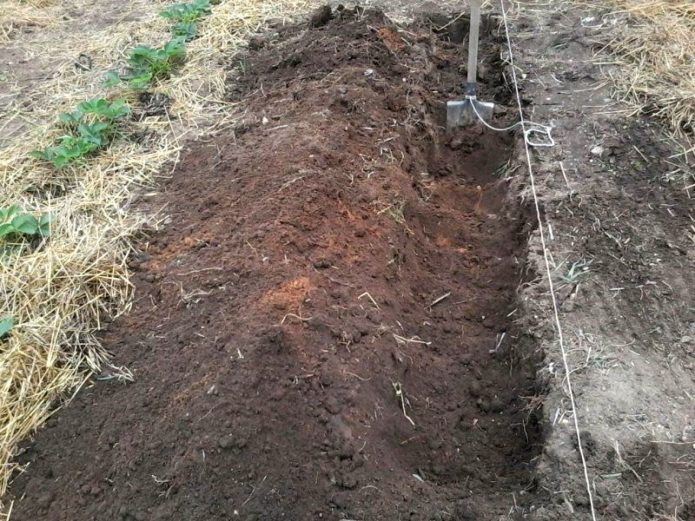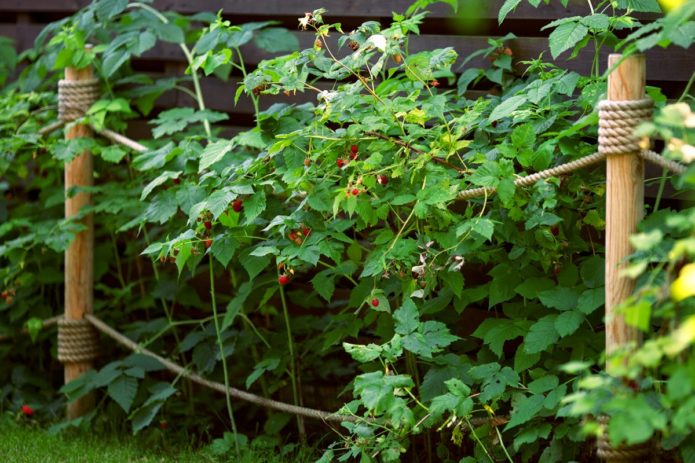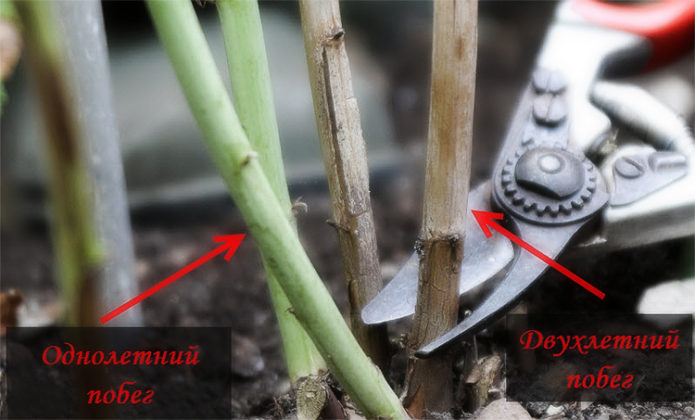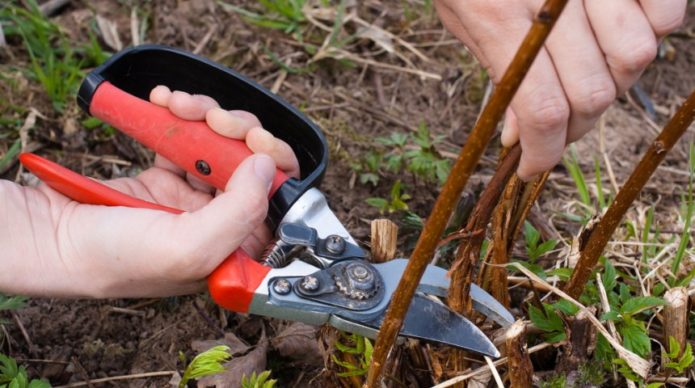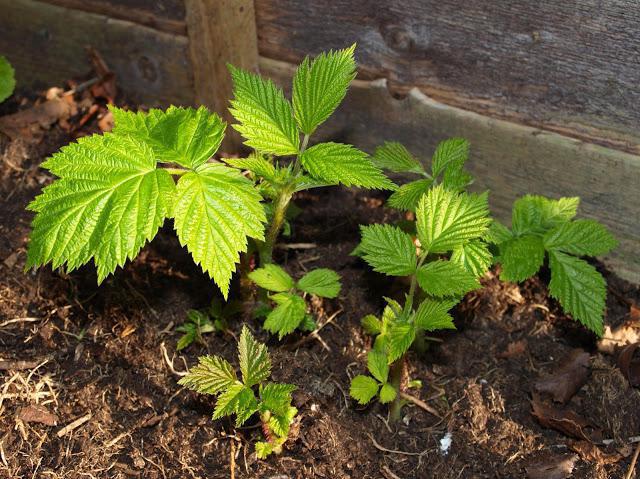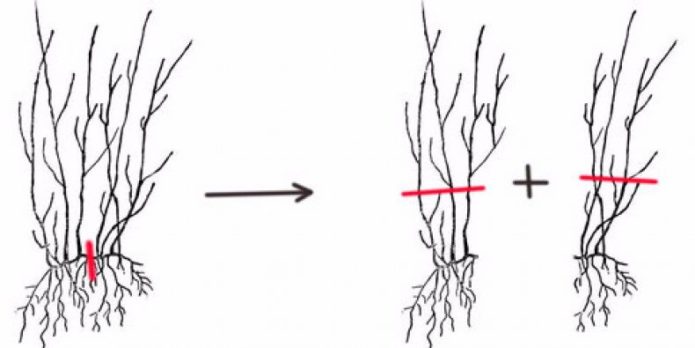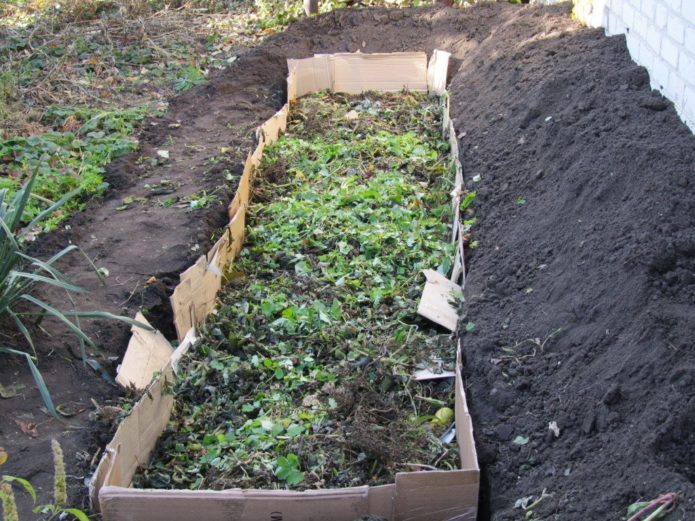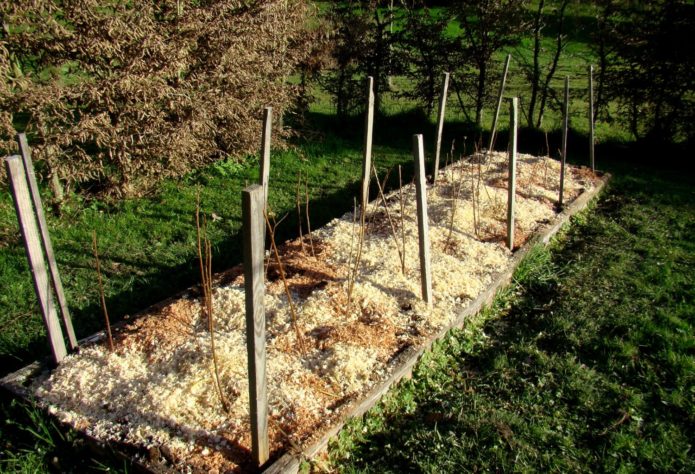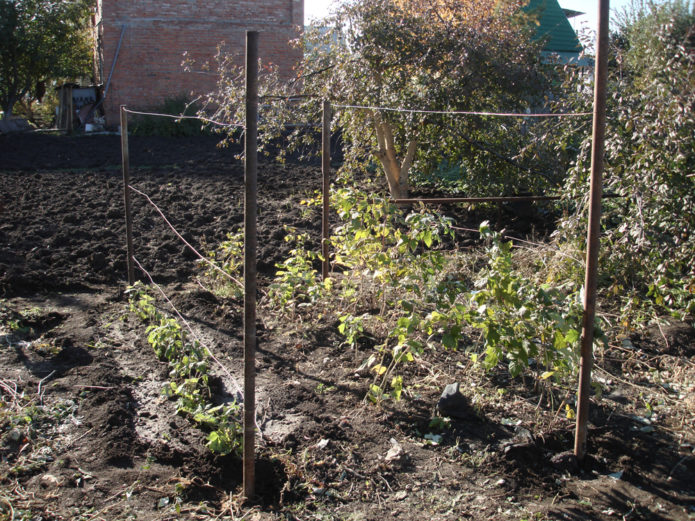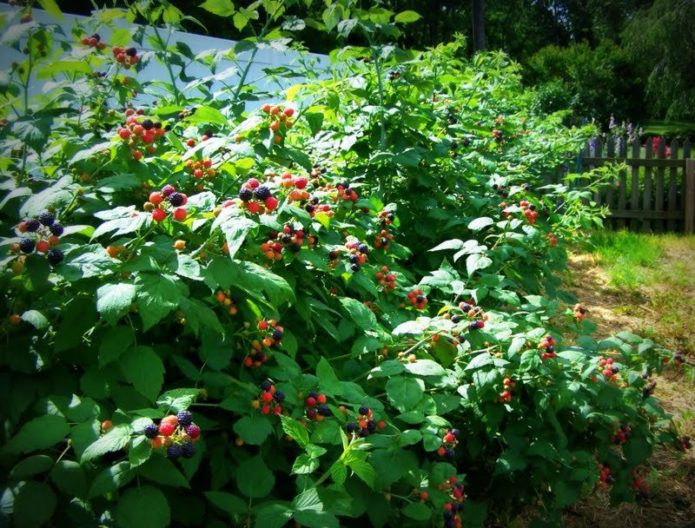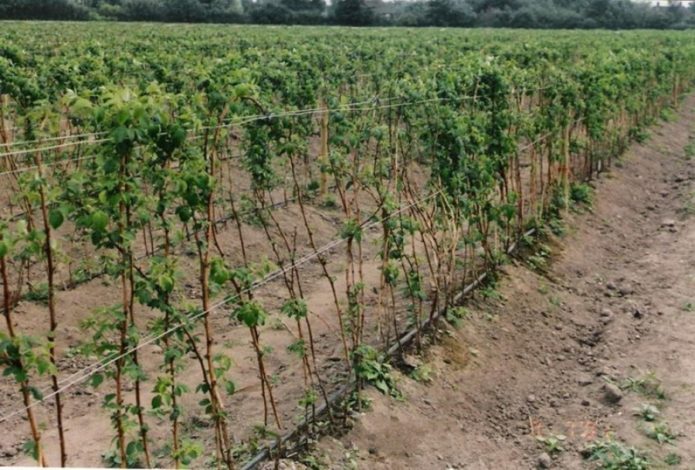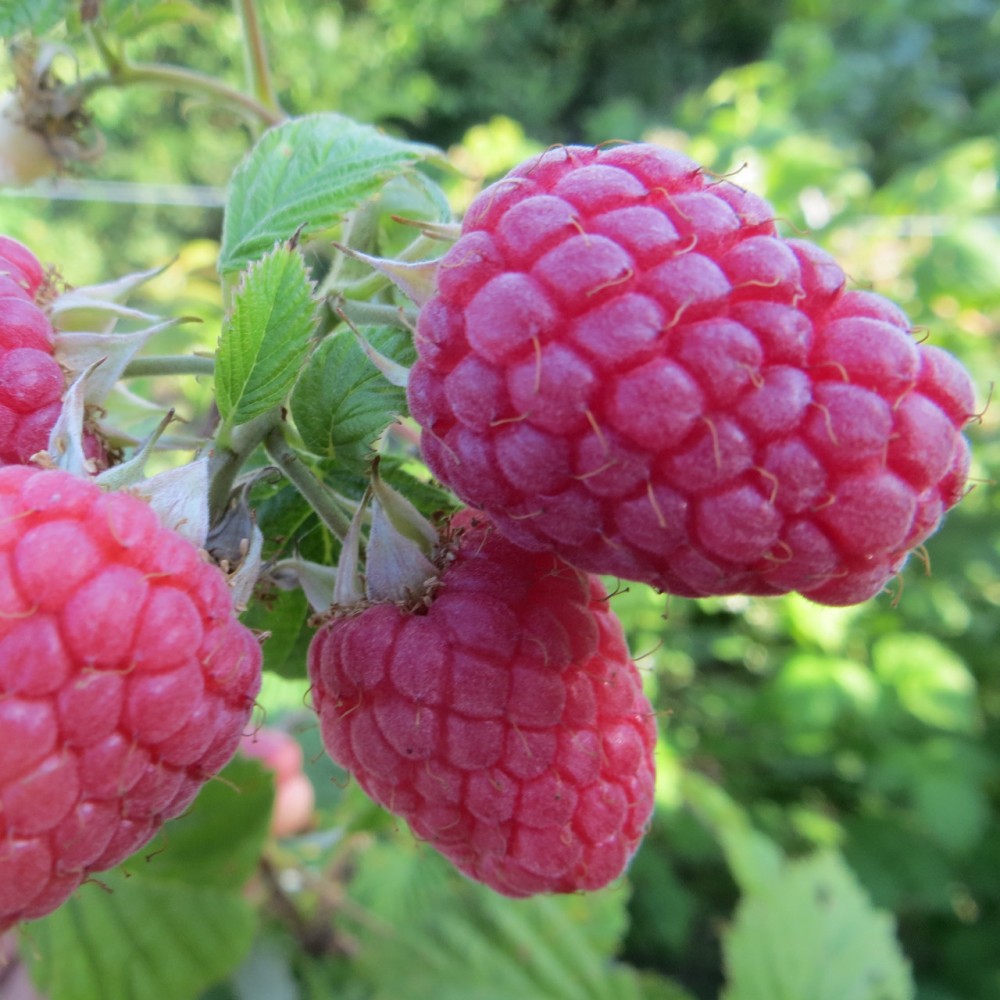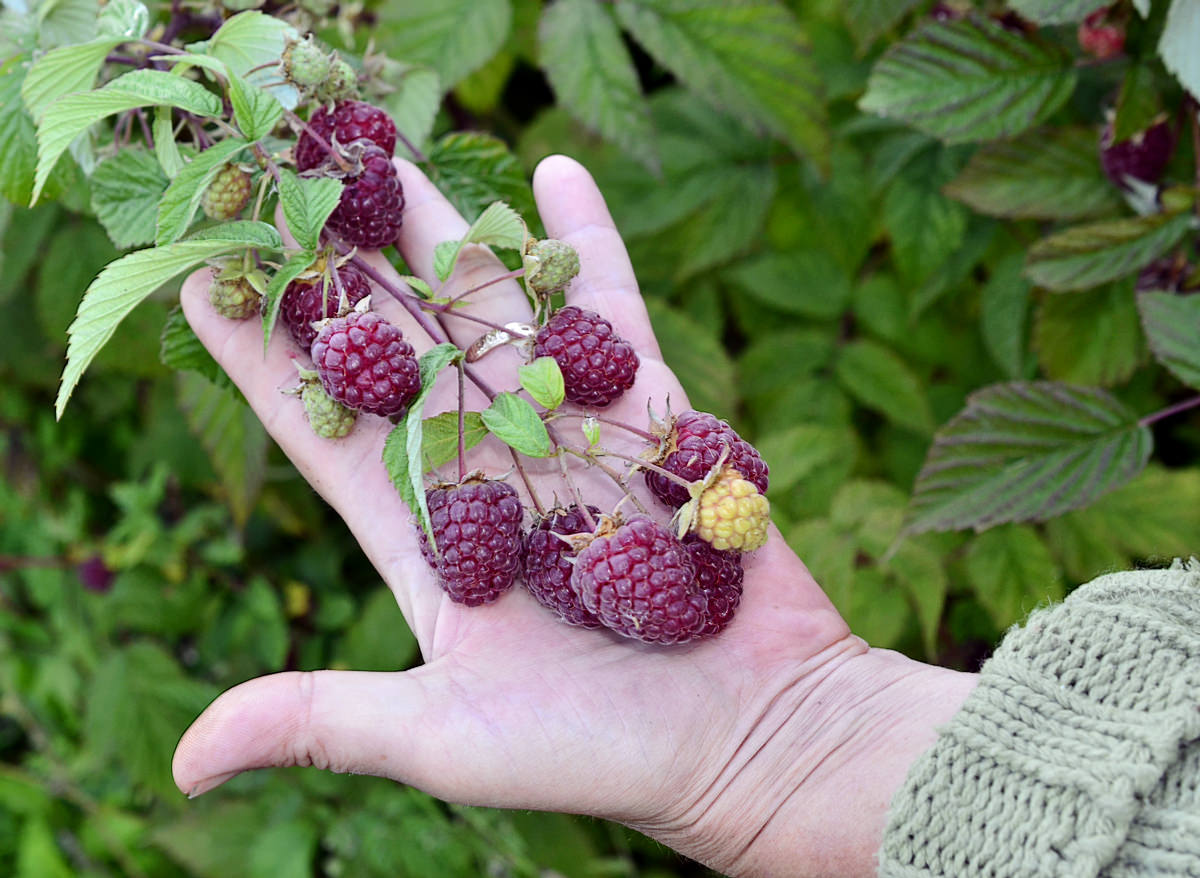Raspberries are a very common berry crop in Russia. Its taste and benefits are known to everyone from childhood. At the same time, the plant is quite aggressive, quickly spreading over the site, capturing new territories. Therefore, not every land-poor summer resident decides to plant it at home. Cultural aggression must be fought, and in general, raspberries require care and care from the gardener, which, of course, will be rewarded with a good harvest of sweet and aromatic berries.
Content
Growing raspberries in the country
Raspberry is a perennial shrub with developmental features: its rhizomes live for a very long time, and the aboveground part - only two years. In the first year, flower buds form on young shoots, from which flowers and berries appear next year, and then the stems die off. The root system is shallow (about 30 cm), so the culture requires systematic watering and feeding. The raspberry tree does not always tolerate winter well if it is not prepared for it. All this testifies to the fact that, having planted raspberries in oneself, one must prepare for a difficult constant work.
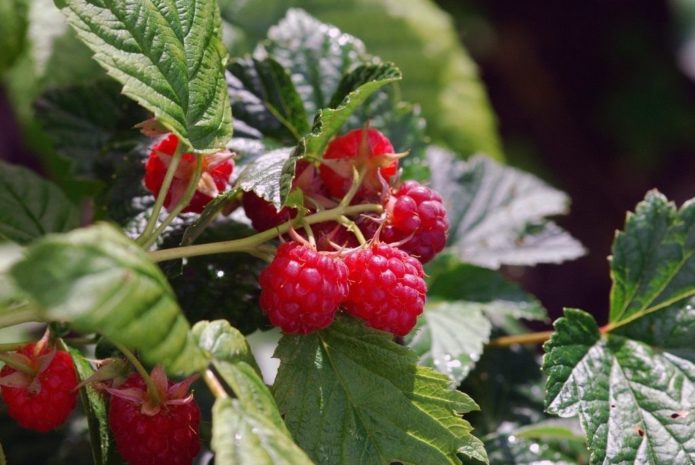
Growing raspberries is time consuming, but the taste and benefits of the berry justify all the efforts
Landing dates
In principle, raspberries can be planted from spring to autumn, but each climatic zone has its own optimal timing:
- in the middle lane and regions with a similar climate, the most reliable planting of raspberries occurs in late September - early October. The time remaining until real frosts is enough for the seedlings to take root. It is not worth doing this too early: replacement buds should form on the roots;
- in the hot south, autumn planting is also preferable, and spring planting is generally risky: seedlings that did not have time to take root can die from early dry weather;
- in the north, it is better to plant in spring: in autumn, early arrival of frosts is possible. It is only necessary to have time to carry out the procedure before the leaves begin to bloom (usually in the spring raspberries are planted in the second half of April).
Choosing a place for planting raspberries
It is believed that raspberries love sunlight, but in the forest they grow on the edges, where they spend part of the time in the shade. So it is in the country: it is important to plant it in a lit place, but not in the sun itself. If around noon, when the sun is too hot, she can hide in the shade, this will be ideal. Wind-blown areas are not suitable for her either.
Honeysuckle, viburnum, jasmine well protect raspberries from the winds.
There should be constantly moist soil under the raspberries, but not swampy.Stagnant water, formed from melting snow or from heavy rains, is detrimental to raspberry roots. But the location of groundwater is usually not an obstacle to planting raspberries.
This means that the very place of raspberries is near a low fence, which protects it from drafts, and periodically - from strong solar radiation. The place at the fence is also convenient from the point of view of the length of stay of raspberries on the site: we plant them in a permanent place for at least 5-6 years. It is only important to fence off the raspberry tree from the neighbors by digging slate or metal sheets up to half a meter deep into the ground near the fence so that the growth does not move to someone else's site.
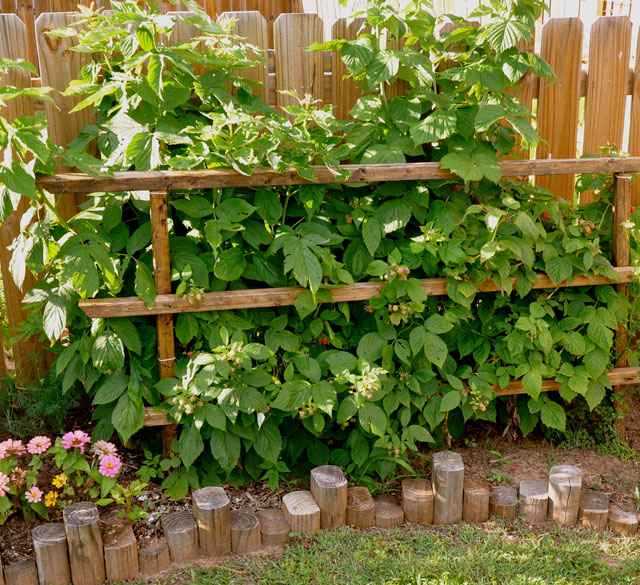
Raspberries planted along a summer cottage fence will not always be in the sun, but they will not suffer from cold winds
You shouldn't plant raspberries right after potatoes, tomatoes, peppers, eggplants - at least a couple of years. Strawberries are also a bad precursor. It is best if green crops, legumes, onions or garlic grew in the garden before it. The best option is to plant siderata in front of the raspberries: herbs that are mowed without waiting for them to bloom. These are oats, vetch, phacelia, lupine, mustard, etc.
On the part of the composition of the soil, the requirements are significant, the main thing is high fertility, the presence of a large amount of humus. The soil should be neutral, or better - slightly acidic, with a pH of about 6 (but not acidic: the presence of horsetail or sorrel indicates the need for deoxidation by liming). The best soils are light sandy loam or loam. Sandy ones are suitable subject to the application of high doses of fertilizers and systematic watering. Raspberry feels bad on clay.
Soil preparation
To obtain good raspberry yields, it is worthwhile to more accurately determine the acidity of the soil. If the pH is more than 7.0, it is necessary to add more low-lying black peat for digging (up to 2 buckets per 1 m2), and if it is less than 5.8 - gradually lime the soil with chalk or slaked lime. Advance digging with careful removal of rhizomes of perennial weeds is required. If the soil is clayey, sand is added (at least a bucket per 1 m2).
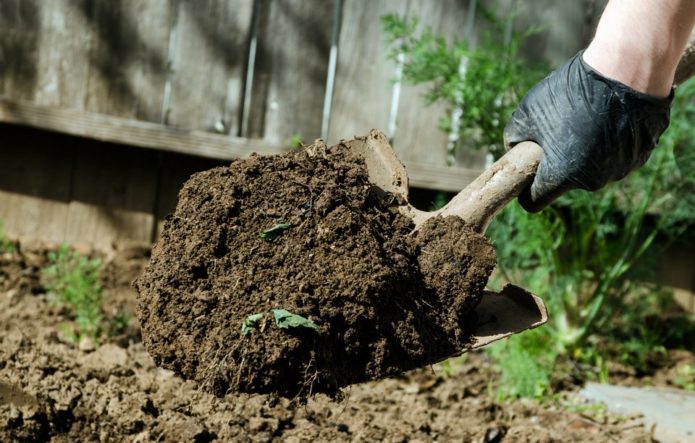
When digging, it is especially important to remove wheatgrass rhizomes, dandelion roots and other malicious perennial weeds
With continuous digging, add for each square meter 1.5–2 buckets of compost or humus, as well as 50 g of potassium sulfate and 80 g of superphosphate (chlorine-containing compounds are not for raspberries!). Wood ash will also not hurt - at least a liter per 1 m2... In addition to potassium and phosphorus, it contains many trace elements. There is enough nitrogen in the humus, so you should not add mineral nitrogen fertilizers as well - the roots of the seedlings will grow poorly, but there will be a lot of greenery.
In the Chernozem region, there is a tradition to add buckwheat or sunflower husks to the soil: this improves the air permeability of the soil.
With shields dug into the ground, it is worth fencing off raspberries not only from neighbors, but also from your vegetable beds.
It is usually not necessary to raise the raspberry tree above ground level, arranging high beds, except in those regions where it is traditionally done because of heavy rainfall, when the water literally stands in the furrows.
Preparation of seedlings
Raspberries can be planted even with pieces of roots, but it is safer, especially for a novice summer resident, to buy ready-made seedlings. They must be chosen according to the state of both the roots and the stems. The stem diameter should be between 5 and 10 mm, and the root system should contain a large number of small, thin but strong roots. They should bend easily, but not break, 15–20 cm in length is sufficient. If some of the roots are dry, it is best to cut them off.
Before planting, the seedlings must be well soaked, dipping completely in water for at least a day. In the absence of a large trough, only the roots are soaked. Before lowering the seedlings into the ground, the roots are dipped in a mash made from mullein and clay (1: 1) using such a volume of water to make a creamy mixture.
Planting raspberries
There are many options for planting raspberries, but the following are most often used:
- in individual landing pits;
- into continuous long furrows (trenches).
The rest of the methods are used less often, in situations other than the standard ones.
With the pit method, planting raspberries is similar to planting other berry bushes and is carried out in pre-prepared planting pits with a diameter of about half a meter and a depth of 40–45 cm. A distance of 80-100 cm is left between the pits, up to 1.5 m between the rows. With careful filling of the soil with fertilizers, you can hardly add them to the pit, but a handful of ash will not hurt in any case. If little fertilizer is added during digging, then the soil taken out of the pit is mixed with a bucket of good humus.
When planting raspberries, it is important to consider the following:
- cut off the stem in autumn, leaving 20-25 cm, in spring - 35-40 cm;
- the root collar as a result should be slightly above ground level: the seedling is placed, leaving 3-4 cm above the soil, but then it is slightly pulled into the moist soil;
- each seedling is watered with at least two buckets of water and the soil must be mulched with a thin layer of humus.
In each hole, you can plant not one seedling, but 2-3, but there is not much sense in this: in the fertile soil, raspberries grow rapidly, and after a couple of years in each planting hole a bush of 6-8 stems will grow.
The trench method involves planting in continuous long furrows up to half a meter wide and 40–45 cm deep, the distance between which is at least a meter. Planting is carried out in the same way as in the pits, but according to a different scheme: about 50 cm is left between the bushes.
Since this method is usually practiced when growing raspberries on a trellis, when young shoots are formed so that raspberries grow in a narrow strip, it is better to orient the furrows from north to south.
Video: how to plant raspberries
Raspberry care
Caring for plants involves watering, feeding, loosening, preventive treatments, garters, pruning, shelter for the winter.
Watering, feeding, mulching
Watering seems to be simple: raspberries need a lot of water. However, if you water it in central Russia in the same way as in the arid south of the country, the roots will simply rot. In arid regions, summer residents, arriving at the site, open the tap of a container with water heated by the sun, and a good half of this container is poured into a raspberry patch: otherwise, berries cannot be obtained. In the middle lane, it happens that watering is not required for weeks if it rains. Accordingly, every summer resident must get used to watering the bushes, focusing on the climate and current weather.
Watering is required if the ground is dry to a depth of about 5 cm. Winter watering is also required, usually carried out at the end of October.
It is advisable to loosen the soil after each watering and heavy rain, but the roots of raspberries are very close to the ground, therefore it is risky to loosen deeply, and most often summer residents replace the procedure with good soil mulching. Under a layer of mulch of 4–6 cm from humus or chopped straw, moisture remains for a long time, and a crust does not form; most weeds do not germinate either.
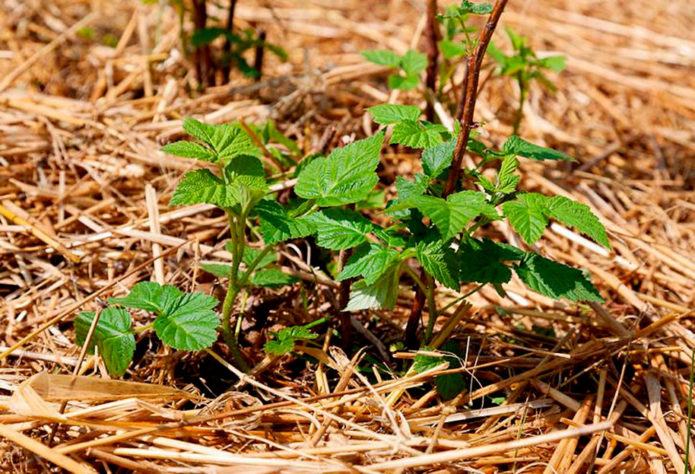
Mulching raspberries with straw is convenient if this material is available, but for the winter it is advisable to replace it with peat or humus, since mice can hibernate in the straw, which are able to gnaw raspberry stalks
It is safer to remove weeds by hand, pulling out from the roots.
Raspberries take a large amount of nutrients from the soil, feeding is mandatory for it. And if the fertilizers applied during planting are enough for 2-3 years for phosphorus and potassium nutrition, then nitrogen must be given the next year after planting. For this purpose, raspberries are watered in spring with infusion of mullein in water (1:10).In summer, it is advisable to feed the plants with phosphorus and potassium fertilizers (a handful of bone meal per 1 m2). In late summer or early autumn, plantings are generously sprinkled with wood ash and shallowly embedded in the soil.
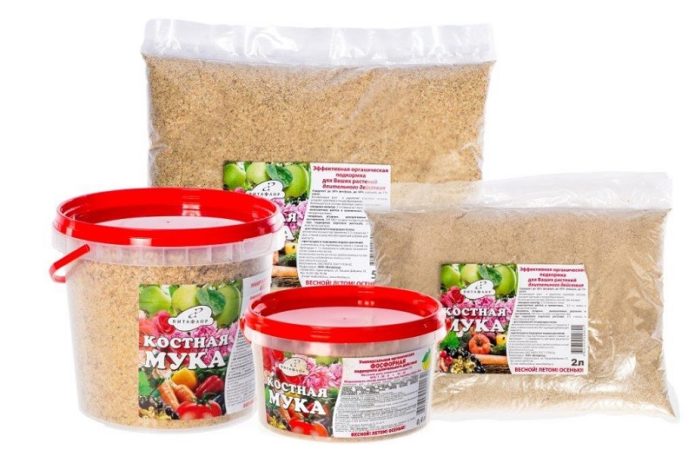
Bone meal contains calcium and phosphorus, necessary for the ripening of raspberries, as well as trace elements magnesium, sodium, iron, copper, zinc, manganese, cobalt, iodine
Garter and trim
There are varieties of raspberries that grow in low bushes and do not require support, but most high-yielding varieties lie on the ground without a garter, so the stems need to be tied to trellises or stakes. In trench cultivation, trellises are equipped, with bush inside the bush, strong stakes with a height of at least a meter are hammered. Tie up the raspberries with strong twine as needed.
They come with a pruner to the raspberry tree after harvesting, but in the summer it makes sense to immediately remove excess growth and too weak young shoots. The main pruning is done in late summer and fall. After fruiting, it is advisable to cut out last year's shoots as soon as possible so that they do not take food on themselves. At the same time, young shoots can also be slightly pruned if they have already grown above the head. It is better to burn everything cut right away: only with full confidence in the absence of diseases and pests can the stems be finely chopped and left as mulch.
In the fall, 2-3 weeks before the onset of frost, a thorough revision of the raspberry tree is carried out. In each bush, no more than 10 young healthy stems (and preferably 6–8) should be left in the winter. When grown on a trellis, 15–20 cm are left between each shoot, that is, about 6 pieces are obtained per running meter of a row. All the rest are cut out without leaving hemp. First of all, sick and broken stems are allowed under the knife, then weak and twisted stems. If new growth has broken through between the bushes, it is also removed.
If there is a lack of planting material, strong shoots can be carefully dug out with the roots and planted in the desired place.
The final touch in autumn pruning is shortening the shoots left in the winter. If they are not very long, you do not need to do this, but for those that have grown to 1.5–2 m, the tops are cut off by 15–20 cm. Usually they ripen poorly and still will not survive the winter.
The described nature of pruning does not apply at all to remontant varieties: the technique is different there. In recent years, a technology has been increasingly used, in which in late autumn, after picking berries, the aerial part is cut off completely from remontants, and the harvest of the next year is harvested only from one-year shoots.
Preparing for winter
Immediately after collecting the last berries, the shrub must be fed so that the young shoots almost do not grow, but get ready for winter. For this, potassium sulfate is used (1 tablespoon per 1 m2) or wood ash (a handful for the same area). At the end of September, they add a bucket of humus to the bush and lightly embed it in the soil, leaving some as mulch. Once every 3 years, instead of humus, raspberries are given 50-60 g of superphosphate and 30-40 g of potassium sulfate per 1 m2adding to them a few grams of manganese and zinc micronutrient fertilizers.
Shortly before frost, raspberries are well watered at the rate of 2-3 buckets of water per 1 m2, but first thoroughly clean it of all plant residues. Fallen leaves, pulled out weeds, cuttings of stems are raked and burned. Then the stems are sprayed prophylactically with 3% Bordeaux liquid.
In most regions, there is enough snow to shelter raspberries from frost if it falls on time and in the right amount. Therefore, they create conditions for snow retention, scattering branches from trees, laying out coniferous spruce branches. Raspberry stalks are trying to bend as low as possible, tying in pairs or in bunches.It is important not to break them and pin them to the ground in any way. Where there are problems with snow, it is advisable to wrap the raspberries in non-woven materials. But this cannot be done ahead of time, since damping is no less scary than freezing.

In regions with little snow, raspberries are not only bent down for the winter, but they also arrange arcs for insulating material
Reproduction of raspberries
There are many ways of reproduction of raspberries and only, perhaps, seed and microclonal (breeding of selective seedlings of raspberries about 1.5 cm in height in a special nutrient medium) are not used by ordinary gardeners: the first can lead to a change in varietal traits, the second is implemented only in specialized laboratories. Suitable methods for summer residents - root suckers, parts of roots (root cuttings), dividing a bush; green cuttings are used much less frequently.
Root offspring
Root offspring (popularly - "nettle") - part of the mother plant, which already has its own root system. In many varieties of such offspring, a sufficient number is formed, and they are located so far from the bush that it is easy to dig them up and transplant them to a new place.
In order for the offspring to be viable, in the summer the weakest specimens are ruthlessly removed, and the strong ones are looked after: watered, loosened, weeded. It is desirable that these offspring are no closer than 25-30 cm from the mother bush. In the fall, they can be planted in a prepared place.
You don't have to wait for autumn, but dig up offspring with a clod of earth in the summer in a state of "nettles". To make it a lot, flowers are systematically cut off from the mother bushes. Then "nettles" are ready for planting already in June with a growth of 12 cm. First, they are seated in a separate garden bed, where it grows up until the autumn planting.
Video: a simple way to propagate raspberries with "nettles"
Root cuttings
If there are not enough offspring, you can use pieces of the roots of a healthy adult plant in the fall. Part of the roots is carefully dug out so as not to do much harm to the mother bush. You need roots with a diameter of 5 to 20 mm, which are cut into pieces 15–20 cm long. They are buried horizontally in fertile soil to a depth of 3–5 cm and covered with a foil. In the spring, after the sprouts appear, the film is removed, and the seedlings are looked after (watered, loosened, weeded). Saplings are ready by the end of summer.

If, for some reason, raspberry root cuttings cannot be planted right away, they can be preserved by placing them in moist moss.
By dividing the bush
They resort to dividing the bush in the case when there are no offspring, it is difficult to get to the roots without disturbing the state of the bush, and the bush itself has grown greatly. Moreover, he must be completely healthy. The bush is divided in autumn or early spring, during a period of relative dormancy. The stems are pre-cut, leaving about 20 cm, and when digging they try not to damage the roots.
The dug out bush sometimes falls apart on its own, otherwise a knife or pruner is used. It is important to divide the bush into such parts, each of which would have 2-3 powerful shoots and a developed root system. The resulting seedlings are immediately planted in a permanent place.
Protecting raspberries from pests and diseases
Disease prevention begins with keeping the raspberry plant clean: despite the fact that it is sent processed in winter, the revision is repeated in the spring. Perhaps some of the shoots have not overwintered and have dried up - they are cut out and burned. In early spring, you can repeat the treatment of the stems with Bordeaux liquid, while the soil around the bushes is also sprayed (if the buds have already turned green, use a 1% solution). The left stems are tied to supports.
If diseases are found, it is necessary to diagnose and choose the correct drug.Diseases of viral origin (witch's broom, curl and mosaic) are practically not treated, you will have to part with the bushes. Fungal diseases (anthracnose, rust, spotting) are cured with copper-containing preparations.
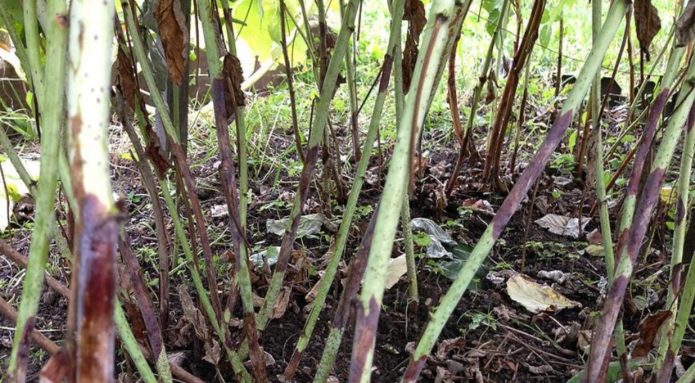
When didimella is affected in early summer, small light purple spots are formed on young raspberry shoots
The main pests of raspberries are the raspberry beetle, stem fly, raspberry gall midge and aphids. To combat them, you have to use insecticides - from the old, well-known Karbofos to the rather toxic Actellik. The use of such drugs should be carried out only as a last resort and in compliance with all precautions.
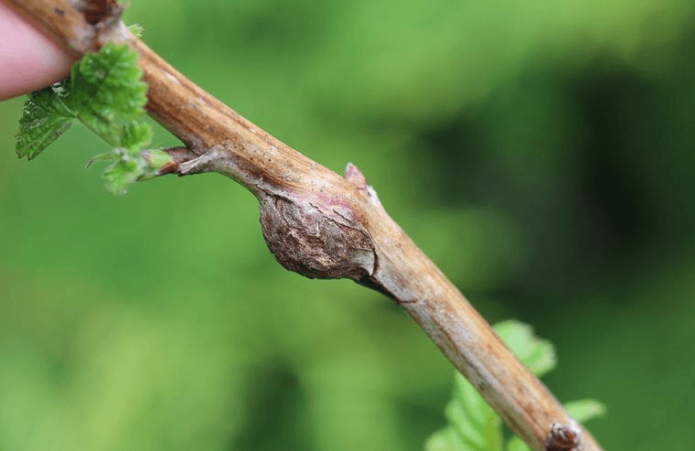
The appearance of round growths on the raspberry stems indicates the defeat of the plant by raspberry gall midge
Raspberry compatibility with other crops
Raspberries feel best without neighbors, but in a summer cottage this is unrealistic. And the point here is often not that some plants will oppress raspberries, but vice versa. That is why the penetration of its roots in breadth is prevented by mechanical barriers.
Sorrel, which contains various types of acids, well prevents raspberries from spreading over the area. If it is planted around the perimeter of the raspberry tree, the appearance of the growth will be noticeably reduced.
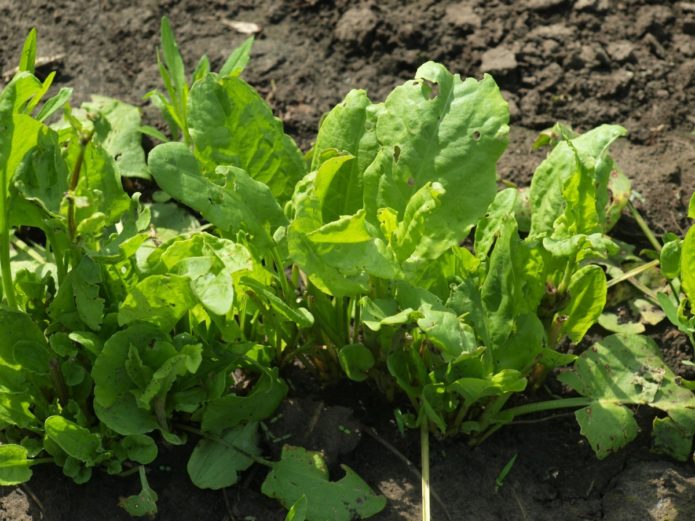
Planting sorrel around the perimeter of the raspberry tree helps many gardeners to cope with the growth of bushes.
There are plants that secrete substances that inhibit the growth of raspberries: parsley, radishes, marigolds, nasturtium. Jasmine, sea buckthorn, elderberry have a bad effect on raspberries. Of course, they do not plant it next to plants with powerful roots and greatly depleting the soil (walnuts, apricots, grapes).
Raspberries share the same diseases and pests with strawberries, strawberries, blackberries, blueberries, so they are also bad neighbors for it. Nearby cherries and plums are undesirable, which give no less growth than raspberries.
It is better not to plant the listed crops closer than 7 m to the raspberry tree. But then what about the land-poor summer residents? Fortunately, there are cultures that live normally next to raspberries. So, the apple tree protects raspberries from fungal diseases, and the raspberries protect the apple tree from scab. Dill works well on raspberries, and most vegetables, if you fence them off from the overgrowth, will be completely neutral about the neighborhood with raspberries.
Video: tips for growing raspberries
Growing raspberries in the country in various ways
In accordance with the planting methods (bush and trench), raspberries are most often grown either as separate bushes, or in strips (ribbons) of different widths. However, there are other, less traditional methods.
In a high bed
In low-lying swampy areas, as well as in cold climates, raspberries have to be planted in higher elevations. To do this, proceed as follows:
- They dig a deep (up to 50 cm) trench.
- At its bottom, various organic waste (sawdust, shavings, household waste, weeds) are placed in a layer of up to 40 cm.
- The soil removed from the trench, mixed with fertilizers, is laid on it.
- Spill well with water.
- Seedlings are placed on the resulting bed almost flush with the ground, the roots are covered with fertile soil and a ridge is formed using auxiliary materials (boards or slate).
- The soil is mulched.
With this approach, the risk of waterlogging of raspberry roots is minimized.
The arrangement of warm beds looks similar, but they are made not in the form of a ridge, but in the form of a traditional, high-rise ridge about 80 cm wide.Heat is generated due to the fact that a large amount of organic matter is placed in a large previously dug hole, which warms the roots of raspberries when rotting. Although warm beds allow you to harvest berries a couple of weeks earlier than usual, they are unpopular for growing raspberries.
In containers
With a shortage of space in the country, you can plant several bushes in large containers that can be placed anywhere, even on asphalt and in waste places. It is important that the container has drainage holes in the bottom.
- A standard 200-liter barrel is cut into 3 parts (since the roots of raspberries are not long, they do not need a deep vessel).
- The cut part is buried in the ground.
- Fill with fertile soil.
- Raspberries are planted.
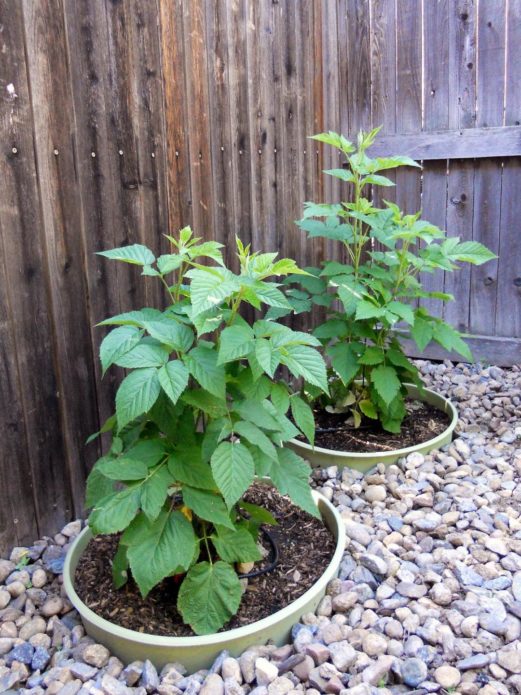
The barrel is cut into 3 parts, shallowly buried in the ground for stability and filled with fertile soil in which the raspberries are planted
Raspberries on a trellis
When growing raspberries in rows or ribbons, they always equip a trellis in advance, to which shoots are tied up within the entire row. When there are several rows, they arrange their own trellis for each.
It is not difficult to make a trellis yourself. For this:
- At the ends of the row, strong pillars of any material are dug in (old metal pipes are often used). The height of the pillar above the ground is 1.5–2 m. If the row is long, several pillars will be required: there cannot be more than 3–4 m between adjacent ones.
- A wire of sufficient strength (with a diameter of at least 4 mm) is pulled between the posts. In this case, the lower tier is located 30–40 cm from the ground, the upper one - 1.5 m, in the middle one more is usually enough. But if the shoots are powerful, and the yield is high, the wire is placed more often.
- As young shoots grow, they are tied to each tier of wire with any strong twine. The shoots are placed along the trellis so that there is a distance of at least 10 cm between them, and preferably 15–20 cm.
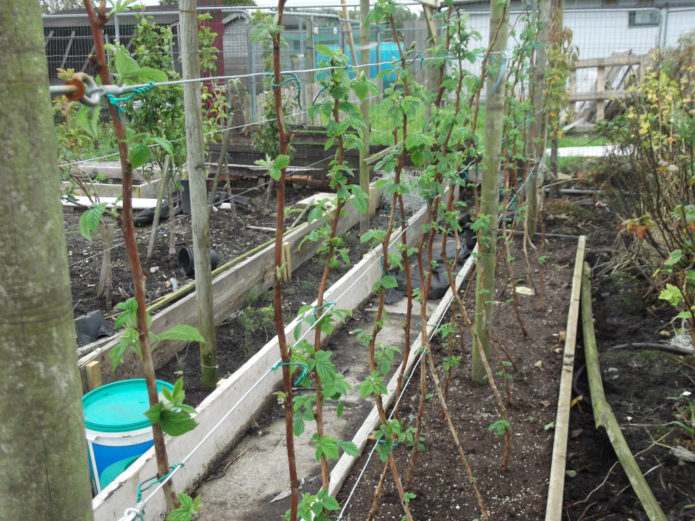
The trellis can be made from any material at hand, but it must be strong, and tying the stems regularly
Instead of wire, you can use any strong mesh made of metal or plastic with large cells (from 15 × 15 cm), placing it vertically.
Bush method
With the bush method, they try to tie all the shoots within the bush to one stake driven in the middle, or to several, if the bush is very voluminous.
Features of growing raspberries in the country in different regions
The place for the raspberry tree is chosen depending on the growing region:
- in Siberia and the Urals, it is important to find a site that is warmer and without strong winds, possibly sacrificing sunlight;
- in the Moscow region, one has to take into account the frequent winter thaws, after which frosts can damage the raspberry tree. Therefore, they avoid those places where melt water accumulates;
- in the south, it is often necessary to hide the raspberry tree in partial shade so that it does not burn out.
Raspberry care varies by region a little more than planting. So, in the middle lane, bending the shoots to the ground for the winter is absolutely necessary, in Siberia they are covered with spruce branches or spunbond, or even roofing material, and in the south they do not even know what a shelter for the winter is.
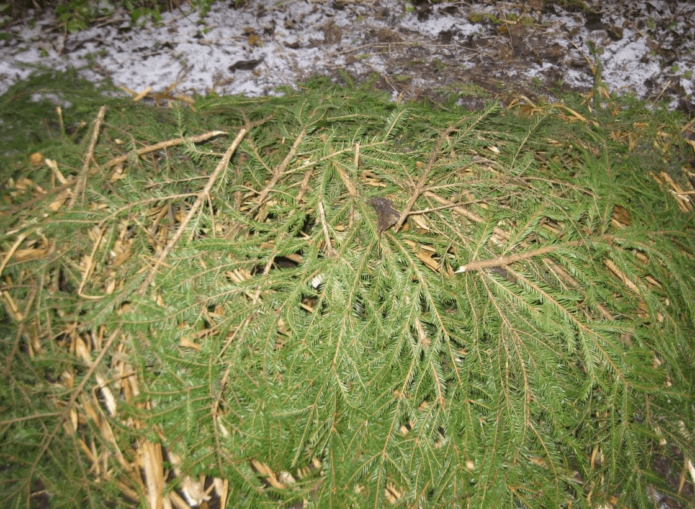
In areas where frequent winds can blow away all the snow, raspberries are covered with spruce branches for the winter.
In most of the southern regions of Russia and in most of Ukraine, there is a different problem: summer heat, and in some places drought. Therefore, here raspberries are kept under a good layer of mulch all year round and they are trying to arrange drip irrigation.
In Belarus, on the contrary, you rarely have to worry about watering, and because of the high humidity, it is necessary to take measures to prevent fungal diseases: thin out the planting, carry out preventive spraying.
The peculiarities of growing raspberries in Crimea are due to high summer temperatures and insufficient rainfall. The heat comes early, even in spring, when the weather in the middle lane is completely comfortable for raspberries. Therefore, raspberries are planted in Crimea in autumn, not earlier than the end of October. If you do this in the spring, the seedlings will not have time to take root, since by the end of April, temperatures up to 30 aboutFROM.
Raspberries in Crimea have to be planted not just in partial shade, but almost in the shade: between buildings, near the walls of houses, etc. At the end of May, all the young shoots that have appeared are removed, and new shoots for the next year are grown from those that appear later. The rest of the agricultural technology is similar to the generally accepted one.
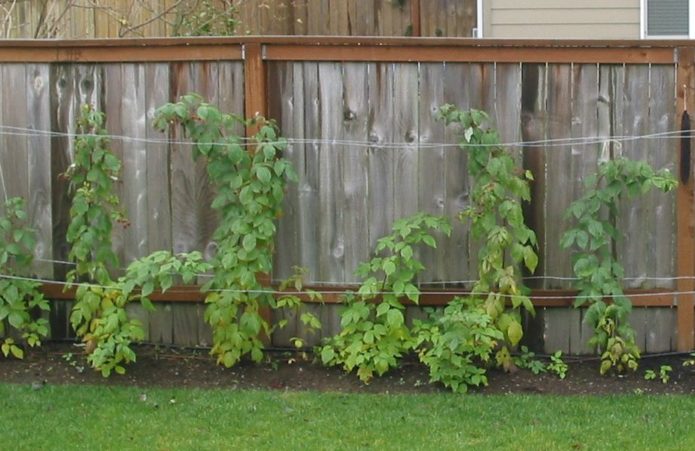
Raspberries in Crimea have to be planted not just in partial shade, but almost in the shade, in order to protect them from too bright sun
Raspberries in summer cottages are a welcome berry, but time consuming. It is not difficult to plant it, but you have to constantly make sure that it does not fill the whole garden, but spends energy on fruiting in the place allotted to it. There is nothing unusual in caring for raspberries, but certain work must be done throughout the year.
